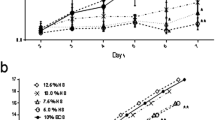Abstract
Systemically unwell patients with extensive wounds present a reconstructive challenge. Conventional skin grafting results in surgical morbidity and donor wounds that may not heal. We propose that cultured skin, in the form of cultured epithelial autografts, be used for wound coverage in these patients. We present two patients with chronic large wounds over the abdomen and the leg. Keratinocytes obtained from a skin biopsy were cultured on a fibrin mat and the cultured epithelial autograft (CEA)–fibrin construct was delivered onto the wound bed 3 weeks later. Initial graft take was 85 and 75 % respectively, and epithelization was complete by 3 weeks. Stable, good quality coverage was maintained at 1.5 years follow-up. We conclude that in a selected group of patients, CEA is a useful modality for the reconstruction of extensive defects with minimum donor site morbidity. The fibrin mat is an optimal system that supports the growth of keratinocytes and allows easy delivery to the wound bed.
Level of Evidence: Level IV, therapeutic study.



Similar content being viewed by others
References
Rheinwald JG, Green H (1975) Serial cultivation of strains of human epidermal keratinocytes: the formation of keratinizing colonies from single cells. Cell 6:331–44
Sood R, Balledux J, Koumanis DJ, Mir HS, Chaudhari S, Roggy D, Zieger M, Cohen A, Coleman JJ (2009) Coverage of large pediatric wounds with cultured epithelial autografts in congenital nevi and burns: results and technique. J Burn Care Res 30:576–86
Simman R, Priebe CJ Jr, Simon M (2000) Reconstruction of aplasia cutis congenita of the trunk in a newborn infant using acellular allogenic dermal graft and cultured epithelial autografts. Ann Plast Surg 44:451–4
Kjartansson J, Dalsgaard CJ, Haegerstrand A, Bjarnason R, Jakobsson B (1991) Transplantation of cultured autologous epithelium after meningococcal septicaemia in a 4-year-old with 35 % skin loss. Scand J Plast Reconstr Surg Hand Surg 25:291–3
Atiyeh BS, Costagliola M (2007) Cultured epithelial autograft (CEA) in burn treatment: three decades later. Burns 33:405–413
Kim DM, Schwerdtner O, Schmidt-Westhausen AM, Kage A, Klein M (2007) Cultured epithelial autografts in the treatment of facial skin defects: clinical outcome. J Oral Maxillofac Surg 65:439–43
Chua AWC, Ma DR, Song IC, Phan TT, Lee ST, Song C (2008) In-vitro comparison in vitro evaluation of fibrin mat and Tegaderm™ wound dressing for the delivery of keratinocytes—implications of their use to treat burns. Burns 34:175–180
Ronford V, Rives JM, Neveux Y, Carsin H, Barrandon Y (2000) Long-term regeneration of human epidermis on third degree burns transplanted with autologous cultured epithelium grown on a fibrin matrix. Transplantation 70:1588–1598
Carsin H, Ainaud P, Le Bever H, Rives J, Lakhel A, Stephanazzi J, Lambert F, Perrot J (2000) Cultured epithelial autografts in extensive burn coverage of severely traumatized patients: a five year single-center experience with 30 patients. Burns 26:379–387
Cirodde A, Leclerc T, Jault P et al (2011) Cultured epithelial autografts in massive burns: a single-center retrospective study with 63 patients. Burns 37:964–972
Yim H, Yang HT, Cho YS et al (2011) Clinical study of cultured epithelial autografts in liquid suspension in severe burn patients. Burns 37:1067–1071
Boyce ST, Goretsky MJ, Greenhalgh DG, Kagan RJ, Rieman MT, Warden GD (1995) Comparative assessment of cultured skin substitutes and native skin autograft for treatment of full-thickness burns. Ann Surg 222:743–52
Wood FM, Kolybaba ML, Allen P (2006) The use of cultured epithelial autograft in the treatment of major burn injuries: a critical review of the literature. Burns 32:395–401
Pellegrini G, Ranno R, Stracuzzi G, Bondanza S, Guerra L, Zambruno G, Micali G, De Luca M (1999) The control of epidermal stem cells (holoclones) in the treatment of massive full-thickness burns with autologous keratinocytes cultured on fibrin. Transplantation 68:868–879
Kamolz LP, Luegmair M, Wick N, Eisenbock B, Burjak S, Koller R, Meissl G, Frey M (2005) The Viennese culture method: cultured human epithelium obtained on a dermal matrix based on fibroblast containing fibrin glue gels. Burns 31:25–29
Llames SG, Del Rio M, Larcher F, García E, García M, Escamez MJ, Jorcano JL, Holguín P, Meana A (2004) Human plasma as a dermal scaffold for the generation of a completely autologous bioengineered skin. Transplantation 77:350–355
Ronfard V, Barrandon Y (2001) Migration of keratinocytes through tunnels of digested fibrin. Proc Natl Acad Sci U S A 98:4504–4509
Burd A, Chiu T (2005) Allogenic skin in the treatment of burns. Clin Dermatol 23:376–387
Druecke D, Steinstraesser L, Homann HH, Steinau HU, Vogt PM (2002) Current indications for glycerol-preserved allografts in the treatment of burn injuries. Burns 28:S26–S30
Stark GB, Kaiser HW (1994) Cologne Burn Centre experience with glycerol-preserved allogeneic skin: part II: Combination with autologous cultured keratinocytes. Burns 20(Suppl 1):S34–38
May SR (1991) The effects of biological wound dressings on the healing process. Clin Mater 8:243–249
Lari AR, Gang RK (2001) Expansion technique for skin grafts (Meek technique) in the treatment of severely burned patients. Burns 27:61–66
Acknowledgments
We are grateful to Prof. Howard Green (Harvard Medical School) for the gift of 3T3-J2 cells. We would like to acknowledge Prof. Tan Suat Hoon of the National Skin Center for histological analysis of the skin biopsy. This work was supported by donation from Exxon-Mobil (Singapore) to SGH Research Grant # 26920370.
Conflict of interest
None.
Author information
Authors and Affiliations
Corresponding author
Rights and permissions
About this article
Cite this article
Wong, M., Chua, A. & Tan, BK. Cultured epithelial autografts for the coverage of large wounds: minimizing skin graft donor sites in the sick patient. Eur J Plast Surg 36, 371–376 (2013). https://doi.org/10.1007/s00238-012-0770-7
Received:
Accepted:
Published:
Issue Date:
DOI: https://doi.org/10.1007/s00238-012-0770-7




